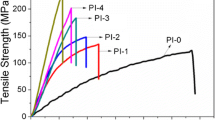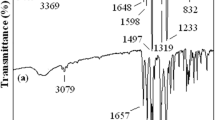Abstract
In order to lower the imidization temperature of polyamic acids (PAA), the catalytic activities of the curing agents p-hydroxybenzoic acid (PHA), quinoline (QL), benzimidazole (BI), benzotriazole (BTA), triethylamine (Et3N) and 1, 8-diazabicyclo [5.4.0]undec-7-ene (DBU) were investigated in the process of thermal imidization of PAA. In addition, the effect of these various curing agents on the thermal stabilities and mechanical properties of the resultant polyimide (PI) films was determined. Quinoline was found to be an effective curing accelerator in the use of two-step method for synthesizing PI. Due to its moderate base strength, low steric crowding effect and moderate boiling point, quinoline could not only accelerate PAA to achieve imidization completely at 180 °C, but also maintain the mechanical properties and thermal stability of the ordinary PI film. Any residual quinoline could be removed from PI films by heating at 250 °C for 4 h.
Similar content being viewed by others
References
Sroog C E. Polyimides[J]. Prog. Polym. Sci., 1991, 16(4): 561–694
Liu H, Wen P, Kim J H, et al. Synthesis and Characterization of Photosensitive Poly(imide sulfonates) for Fuel Cell Application[J]. J. Wuhan. Univ. Technol., 2013, 28(4): 635–642
Ding M X. Polyimides: Chemistry, Relationship between Structure and Properties and Materials[M]. Beijing: Chinese Science Press, 2006
Liaw D J, Wang K L, Huang Y C, et al. Advanced Polyimide Materials: Syntheses, Physical Properties and Applications[J]. Prog. Polym. Sci., 2012, 37(7): 907–974
Kuznetov A A, Tsegelskaya A Y, Belov M Y, et al. Acid-catalyzed Reactions in Polyimide Synthesis[J]. Macromol. Symp., 1998, 128(1): 203–219
Ali A A M, Ahmad Z. The Effect of Curing Conditions and Aging on the Thermo-mechanical Properties of Polyimide and Polyimide-silica Hybrids[J]. J. Mater. Sci., 2007, 42(19): 8363–8369
Oba M. Effect of Curing Accelerators on Thermal Imidization of Polyamic Acids at Low Temperature[J]. J. Polym. Sci. Polym. Chem., 1996, 34(4): 651–658
Jin Z X, Ishii H. A Novel Positive-Type Photosensitive Polyimide Based on Soluble Block Copolyimide Showing Low Dielectric Constant with a Low-Temperature Curing Process[J]. J. Appl. Polym. Sci., 2006, 100(5): 4240–4246
Nelson A, Guerra G, Williams D J, et al. Catalytic Activity of Benzimidazole in the Imidization of Polyamic Acids[J]. J. Appl. Polym. Sci., 1988, 36(1): 243–248
Ding Y, Bikson B, Nelson J K. Polyimide Membranes Derived from Poly(amic acid) Salt Precursor Polymers. 1. Synthesis and Characterization[J]. Macromolecules, 2002, 35(3): 905–911
Ahn T, Choi Y, Jung H M, et al. Fully Aromatic Polyimide Gate Insulators with Low Temperature Processability for Pentacene Organic Thin-film Transistors[J]. Org. Electron., 2009, 10(1): 12–17
Shirai Y, Tokiwa S, Kawauchi T, et al. Influence of Additives on the Imidization of Poly(amide acid)[J]. J. Photopolym. Sci. Technol., 2012, 25(3): 389–393
Rusanov A L, Komarova L G, Sheveleva T S, et al. New Aryloxy-Substituted Condensation Polymers[J]. React. Funct. Polym., 1996, 30(1-3): 279–292
Huang W, Yan D, Lu Q. Synthesis and Properties of Polyimides from 1, 3-bis (4-piperidino-l, S-naphthalic anhydride) Propane[J]. Polym. Bull., 2003, 49(6): 417–423
Wang K, Fan L, Liu J G, et al. Preparation and Properties of Meltprocessable Polyimides Based on Fluorinated Aromatic Diamines and Aromatic Dianhydrides[J]. Appl. Polym. Sci., 2008, 107(15): 2126–2135
Rangel E R, Maya E M, Sanchez F, et al. Gas Separation Properties of Mixed-matrix Membranes Containing Porous Polyimides Fillers[J]. J. Memb. Sci., 2013, 447(15): 403–412
Marek M, Schmidt P, Schneider B, et al. Imidization of Polypromellitamic Acid Based on 4, 4’–Methylenedianiline[J]. Macromol. Chem. Phys., 1990, 191(11): 2631–2637
Xu Y, Wang S, Li Z, et al. Polyimide Fibers Prepared by Dry-spinning Process: Imidization Degree and Mechanical Properties[J]. J. Mater. Sci., 2013, 48(22): 7863–7868
Kailani M H, Sung C S P. Chemical Imidization Study by Spectroscopic Techniques. 2. Polyamic Acids[J]. Macromolecules, 1998, 31(17): 5779–5784
Brandom D K, Wilkes G L. Influence of Thermal Imidization on the Crystallization and Melting Behavior of the Aromatic Polyimide, LaRC CPI-2[J]. Polymer, 1995, 36(21): 4083–4089
Yoon J Y, Jeong S, Lee S S, et al. Enhanced Performance of Solution-Processed Organic Thin-Film Transistors with a Low-Temperature-Annealed Alumina Interlayer between the Polyimide Gate Insulator and the Semiconductor[J]. ACS. Appl. Mater. Interfaces, 2013, 5(11): 5149–5155
Author information
Authors and Affiliations
Corresponding author
Rights and permissions
About this article
Cite this article
Xu, Y., Zhao, A., Wang, X. et al. Influence of curing accelerators on the imidization of polyamic acids and properties of polyimide films. J. Wuhan Univ. Technol.-Mat. Sci. Edit. 31, 1137–1143 (2016). https://doi.org/10.1007/s11595-016-1502-9
Received:
Accepted:
Published:
Issue Date:
DOI: https://doi.org/10.1007/s11595-016-1502-9




